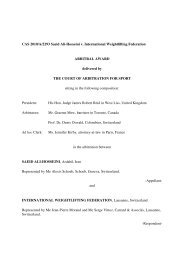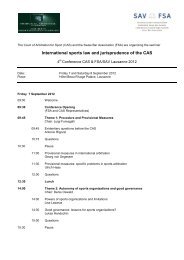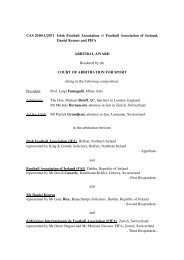(CAS) Bulletin - Tribunal Arbitral du Sport / TAS
(CAS) Bulletin - Tribunal Arbitral du Sport / TAS
(CAS) Bulletin - Tribunal Arbitral du Sport / TAS
Create successful ePaper yourself
Turn your PDF publications into a flip-book with our unique Google optimized e-Paper software.
over the emerging game of indoor soccer. FIFA<br />
sought to extend its control to encompass indoor<br />
as well as outdoor soccer by directing its national<br />
affi liated bodies, including the ASF, to impose bans<br />
on players who played in FIFUSA-sponsored indoor<br />
soccer competitions. In turn, the ASF directed its<br />
regional affi liate, the Queensland Soccer Federation,<br />
to ban the plaintiff from playing in its outdoor<br />
competitions. Recognizing the primacy of Australian<br />
national law, the court rejected the ASF’s defense that<br />
it was contractually obligated to follow FIFA’s rules<br />
and may be disciplined by FIFA for failing to ban the<br />
plaintiff.<br />
An analogous example of the traditional approach<br />
is the European Court of Justice (ECJ)’s 1995 ruling<br />
applying European transnational laws in Union<br />
Royale Belge des Sociétiés de Football Association<br />
ASBL v Bosman, perhaps the world’s most famous<br />
sports law case 49 . It involved a successful challenge<br />
to the core labor market rules of soccer, the world’s<br />
most widely played and followed sport. The plaintiff<br />
was an out-of-contract Belgian professional player<br />
who was offered a contract to play for a French<br />
soccer club. The rules of the defendant Belgian<br />
soccer governing body incorporated European<br />
Union of Football Associations (UEFA) regulations<br />
establishing a transfer fee system and limiting the<br />
number of nonnationals who could play for domestic<br />
professional clubs. Despite plaintiff’s uncontracted<br />
status, he needed his former club’s approval to play<br />
for a new club, which was conditioned upon the<br />
latter’s payment of a prescribed player transfer fee.<br />
The player transfer fee requirement was part of<br />
an elaborate international system (of which FIFA<br />
and UEFA were the main proponents) governing<br />
the movement of soccer players between clubs--a<br />
system which an English court some years earlier<br />
had described as “a united monolithic front all over the<br />
world 50 ”. The ECJ held that these rules contravened<br />
article 48 of the then-European Community Treaty<br />
(now article 45 of the Treaty on European Union<br />
(EU Treaty)), which guarantees European workers<br />
freedom of movement between member countries and<br />
49. 1995 E.C.R. I-4921 (E.C.J.). The case and its consequences have<br />
generated a voluminous literature in books and articles. See, e.g.,<br />
ROGER BLANPAIN & RITA INSTON, The Bosman Case: The End of<br />
the Transfer System? (1996); David MCARDLE, From Boot Money<br />
to Bosman: Football, Society and the Law (2000); Stefaan VAN DEN<br />
BOGAERT, Practical Regulation of the Mobility of <strong>Sport</strong>smen in the<br />
EU Post Bosman (2005); Braham Dabscheck, The Globe at Their<br />
Feet: FIFA’s New Employment Rules--I, <strong>Sport</strong> in Soc’y, Spring 2004,<br />
at 1, 69; Braham DABSCHECK, The Globe at Their Feet: FIFA’s New<br />
Employment Rules--II, <strong>Sport</strong> in Soc’y, Jan. 2006, at 1, 1; P.E. Morris,<br />
S. MORROW & P.M. SPINK, EC Law and Professional Football: Bosman<br />
and Its Implications, 59 Mod. L. Rev. 893 (1996); Jens Pelle VAN DEN<br />
BRINK, E.C. Competition Law and the Regulation of Football: Part I,<br />
21 Eur. Competition L. Rev. 359 (2000); Jens Pelle VAN DEN BRINK,<br />
E.C. Competition Law and the Regulation of Football: Part II, 21 Eur.<br />
Competition L. Rev. 420 (2000).<br />
50. Eastham v. Newcastle United Football Club Ltd., [1964] Ch. 413 at<br />
438 (Eng.).<br />
prohibits discrimination on grounds of nationality 51 .<br />
Bosman generated a “welter of publicity” 52 , but it was an<br />
unsurprising result to informed observers 53 because<br />
the court ruled that international sports rules and<br />
agreements are subject to applicable transnational<br />
laws; here, a regional international treaty is given<br />
domestic application 54 .<br />
In contrast to the foregoing traditional view is<br />
the deferential approach of some courts, which<br />
demonstrates a judicial reluctance to apply national<br />
laws to Olympic and international sports rules and<br />
agreements. For example, some national courts have<br />
refused to apply national laws protecting human<br />
rights to international sports competitions held<br />
within their respective country’s borders.<br />
United States courts generally have rejected claimed<br />
violations of federal or state law in connection<br />
with Olympic Games hosted by American cities.<br />
For example, in Martin v. International Olympic<br />
Committee, the United States Court of Appeals for<br />
the Ninth Circuit affi rmed the denial of a preliminary<br />
injunction to require the organizers of the 1984<br />
Los Angeles Summer Olympic Games to include<br />
5,000- and 10,000-meter track events for women,<br />
which already existed for men 55 . The court rejected<br />
plaintiffs’ claims that the failure to include these<br />
events constituted illegal gender discrimination, even<br />
51. The ECJ considered it unnecessary to adjudicate plaintiff’s claim<br />
that the rules contravened articles 85 and 86 (now articles 101 and 102)<br />
relating to freedom of economic competition.<br />
52. MORRIS, Morrow & Spink, supra note 108, at 902.<br />
53. Courts in other countries had long recognized the contrariness of<br />
such transfer systems to laws protecting freedom of economic<br />
competition and employment. See, e.g., Mackey v. NFL, 543 F.2d 606<br />
(8th Cir. 1976); Buckley v Tutty (1971) 125 CLR 353 (Austl.); Blackler<br />
v N.Z. Rugby Football League, Inc. [1968] NZLR 547. In Europe,<br />
serious doubt existed as well. See, e.g., Eastham v. Newcastle United<br />
Football Club Ltd., [1964] Ch. 413 (Eng.); Janssen VAN RAAY, Report of<br />
the Committee on Legal Affairs and Citizens’ Rights on the Freedom<br />
of Movement of Professional Footballers in the Community (European<br />
Parliament, Session Documents Series A, Mar. 1, 1989).<br />
54. Bosman demonstrates that court rulings which apply national laws<br />
to interna-tional sports rules and agreements can prove to be problematic<br />
because they do not accommodate the special circumstances and needs<br />
of international sports. FIFA responded to the ruling by amending its<br />
transfer regulations, which caused some Belgian trade unions to fi le<br />
a complaint with the European Commission alleging contravention<br />
of competition law (articles 85 and 86 of the EC Treaty--now articles<br />
101 and 102 of the EU Treaty). Following protracted negotiation and<br />
political lobbying, <strong>du</strong>ring which FIFA and UEFA were able to convince<br />
the Commission of the special economics and social status of soccer, an<br />
agreement was reached on new Regulations for the Status and Transfer<br />
of Players to apply worldwide. See Braham DABSCHECK, The Globe at<br />
Their Feet: FIFA’s New Employment Rules--I, <strong>Sport</strong> in Soc’y, Spring<br />
2004, at 1, 69. The development of the new rules was strongly infl uenced<br />
by European perspectives and it is an issue worthy of scholarly<br />
investigation as to whether the socioeconomic and legal perspectives<br />
of Asia and the Americas have been suffi ciently considered in adopting<br />
these worldwide rules.<br />
55. Martin v. Int’l Olympic Comm., 740 F.2d 670 (9th Cir. 1984).<br />
American courts also have rejected state discrimination law claims by<br />
foreign athletes seeking to march in opening ceremonies in Olympic<br />
Games held in the United States under fl ags of countries not recognized<br />
by the IOC. See Ren-Guey v. Lake Placid 1980 Olympic Games, Inc.,<br />
424 N.Y.S.2d 535 (N.Y. App. Div. 1980), aff’d, 429 N.Y.S.2d 473 (1980);<br />
Spin<strong>du</strong>lys v. L.A. Olympic Org. Comm., 220 Cal. Rptr. 565 (Cal. Ct.<br />
App. 1985).<br />
Articles et commentaires / Articles and commentaries<br />
-<br />
8





